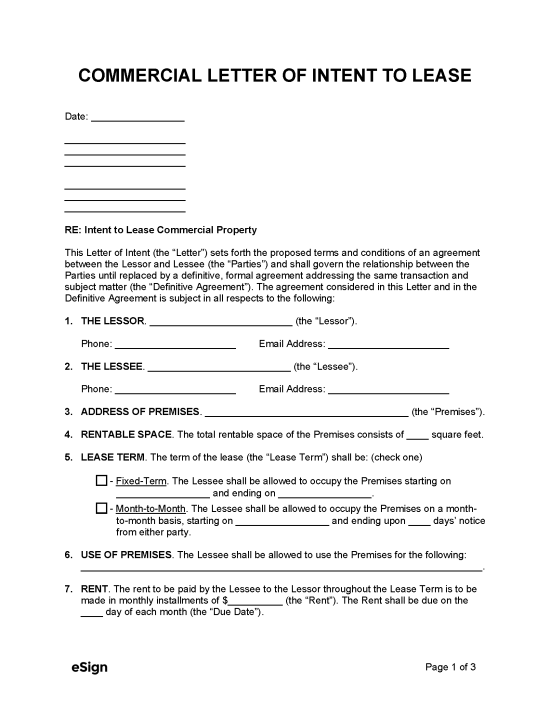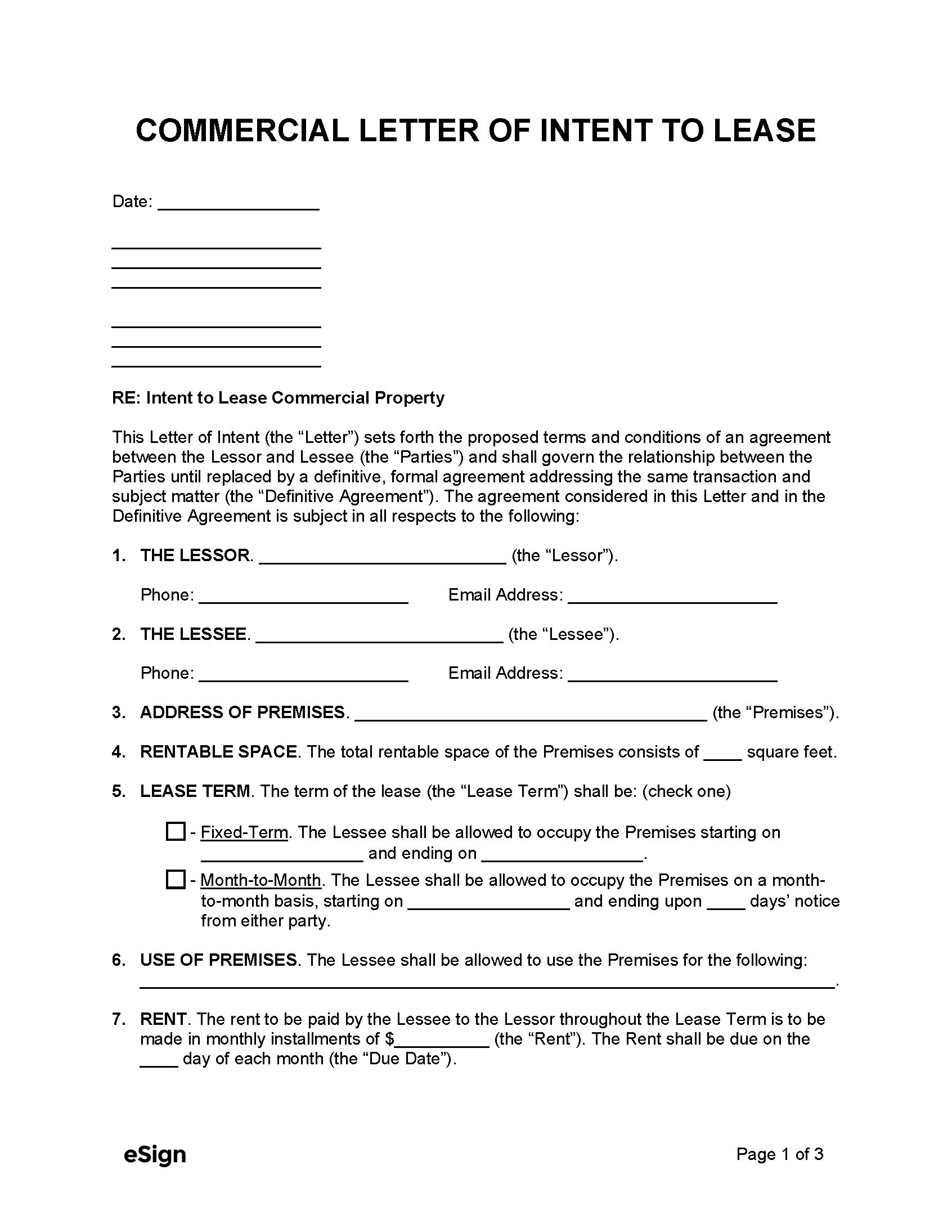Related Forms
- Commercial Lease Application – Used to vet potential tenants before drafting a commercial lease agreement.
- Commercial Lease Agreement – A legally binding agreement to rent non-residential property.
Necessary Terms
Contact Information
A letter of intent (LOI) must identify the sender (lease applicant) and the recipient (landlord) and should include their phone numbers and email addresses.
Intention to Lease
The lease applicant (or their broker) should summarize their intention to enter into a binding rental agreement with the landlord.
Principal Rental Terms
While the letter of intent won’t cover all aspects of a commercial lease agreement, it must at the very least identify the basic terms of the proposed lease, such as:
- The property address
- The lease duration
- The monthly rent and utility fees
- Payment due dates
- Who will be responsible for maintenance and repairs
- Security deposit requirements
Binding and Non-Binding Conditions
A letter of intent should include a statement identifying the terms that will and will not be legally binding upon the parties involved.
Signatures
The LOI must contain the signatures of the landlord and tenant. Next to each signature should be the signing date and the individual’s printed name.
Sample
Download: PDF, Word (.docx), OpenDocument
COMMERCIAL LETTER OF INTENT TO LEASE
Date: [DATE]
[SENDER (e.g., LEASE APPLICANT) NAME]
[SENDER STREET ADDRESS]
[SENDER CITY, STATE, ZIP]
[RECIPIENT (e.g., LESSOR) NAME]
[RECIPIENT STREET ADDRESS]
[RECIPIENT CITY, STATE, ZIP]
RE: Intent to Lease Commercial Property
This Letter of Intent (the “Letter”) sets forth the proposed terms and conditions of an agreement between the Lessor and Lessee (the “Parties”) and shall govern the relationship between the Parties until replaced by a definitive, formal agreement addressing the same transaction and subject matter (the “Definitive Agreement”). The agreement considered in this Letter and in the Definitive Agreement is subject in all respects to the following:
1. THE LESSOR. [LESSOR NAME] (the “Lessor”).
Phone: [LESSOR PHONE] Email Address: [LESSOR EMAIL]
2. THE LESSEE. [LESSEE NAME] (the “Lessee”).
Phone: [LESSEE PHONE] Email Address: [LESSEE EMAIL]
3. ADDRESS OF PREMISES. [PREMISES ADDRESS] (the “Premises”).
4. RENTABLE SPACE. The total rentable space of the Premises consists of [#] square feet.
5. LEASE TERM. The term of the lease shall commence on [LEASE START DATE] and end on [LEASE END DATE] (the “Lease Term”).
6. USE OF PREMISES. The Lessee shall be allowed to use the Premises for the following: [DESCRIBE BUSINESS ACTIVITY TO BE CONDUCTED ON PREMISES].
7. RENT. The rent to be paid by the Lessee to the Lessor throughout the Lease Term is to be made in monthly installments of $[RENT AMOUNT] (the “Rent”). The Rent shall be due on the [#] day of each month (the “Due Date”).
8. LATE FEE. If Rent is not paid by the Due Date, the Lessee shall be required to pay the following late fee: [DESCRIBE LATE FEE (IF ANY)].
9. EXPENSES. The Lessee shall be required to pay the following monthly expenses in addition to the Rent: [LIST EXPENSES TO BE PAID BY LESSEE].
The Lessor shall be required to pay the following monthly expenses: [LIST EXPENSES TO BE PAID BY LESSOR].
10. DEPOSIT. The Parties agree that a security deposit [WRITE “will” OR “will not”] be required. If required, a security deposit in the amount of $[DEPOSIT AMOUNT] shall be paid by the Lessee to the Lessor prior to or upon the signing of a lease.
Note: If a security deposit will not be required, delete the sentence beginning with “If required” above.
11. INTENTION OF THE PARTIES. This Letter sets forth the intentions of the Parties to use reasonable efforts to negotiate, in good faith, a Definitive Agreement with respect to all matters herein. Notwithstanding paragraphs 11 through 13, which shall be legally binding, any legal obligations with respect to all other matters shall only arise if and when the Parties execute and deliver a Definitive Agreement.
12. GOVERNING LAW. This Letter shall be governed under the laws of the State of [STATE NAME].
13. SIGNATURES.
Lessor’s Signature: ___________________ Date: [MM/DD/YYYY]
Print Name: [LESSOR NAME]
Lessee’s Signature: ___________________ Date: [MM/DD/YYYY]
Print Name: [LESSEE NAME]
Purpose of a Letter of Intent
A letter of intent to lease is used to discuss the terms of a rental arrangement before signing a binding contract. The provisions can be negotiated until both parties are satisfied, after which the letter will act as the foundation for the final lease agreement.
An LOI is a negotiation tool that also demonstrates the applicant’s interest and sincerity, which some landlords require when screening potential tenants.
When to Use
A letter of intent is most commonly used when a landlord and tenant begin negotiating terms for a commercial lease agreement. Either party will fill out the letter to summarize their rental offer and demonstrate their desire to sign a binding contract.
The letter is also sometimes used after the parties reach a verbal arrangement to get some of the terms in writing before they draft the definitive contract.

